HON HAI PRECISION IND J07H06903 802.11a/b/g WLAN Mini PCI Module User Manual Hardware Guide
HON HAI Precision Ind. Co., Ltd. 802.11a/b/g WLAN Mini PCI Module Hardware Guide
Contents
Host laptop users manual 2

Hardware Guide 3–1
3
Battery Packs
Running the Tablet PC on Battery
Power
When the tablet PC is connected to external power, the tablet PC
runs on external power.
When a charged battery pack is in the tablet PC and the tablet PC
is not connected to external power, the tablet PC runs on battery
power.
The tablet PC switches between external power and battery power
according to the availability of an external power source. For
example, if the tablet PC contains a charged battery pack and is
running on external power supplied through the AC adapter, the
tablet PC will switch to battery power if the AC adapter is
disconnected from the tablet PC.
Whether to leave a battery pack in the tablet PC or in
storage depends on how you work. Keeping a battery pack in
the tablet PC enables the battery pack to charge whenever the
tablet PC is connected to external power and also protects your
work in case of a power outage.
On the other hand, a battery pack in the tablet PC slowly
discharges even while the tablet PC is turned off.
If you will not be using the tablet PC for one month or more,
removing the battery pack and storing it as described in “Storing
a Battery Pack,” later in this chapter, will prolong its life. For
more information about leaving your work, refer on this CD to
the Software Guide, “Power” chapter.
331734-001.book Page 1 Monday, July 14, 2003 3:47 PM

3–2 Hardware Guide
Battery Packs
Replacing a Battery Pack
Removing a Battery Pack
ÄCAUTION: To prevent loss of work when removing a battery pack that is
running the tablet PC, initiate Hibernation or turn off the tablet PC before
removing the battery pack.
■If you remove a battery pack that is running the tablet PC while
the tablet PC is in Standby, your work is saved in Standby for up to
one minute, then the tablet PC shuts down and your unsaved work
is lost.
■If you remove a battery pack that is running the tablet PC while the
tablet PC is on, the tablet PC shuts down immediately and your
unsaved work is lost.
To remove a battery pack from the tablet PC:
1. Turn the tablet PC front side down. (If a battery pack security
screw is in place, remove the screw.)
331734-001.book Page 2 Monday, July 14, 2003 3:47 PM
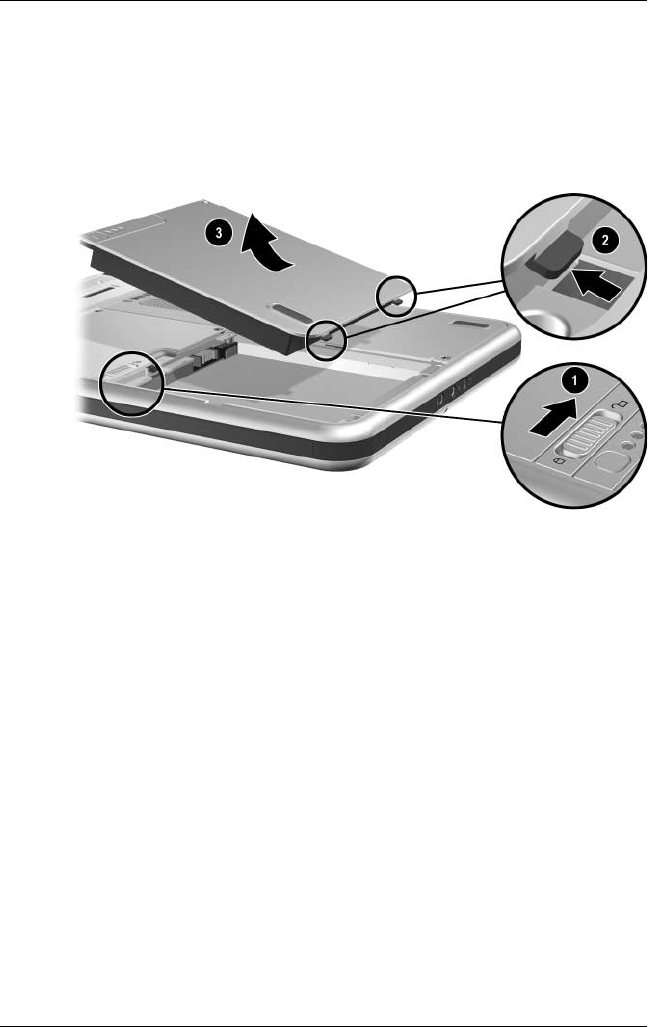
Battery Packs
Hardware Guide 3–3
2. To unlock the battery pack release latch, slide the latch firmly
toward the unlock icon 1. Then hold the latch as you
disengage the 2 tabs on the battery pack from the 2 slots
on the battery bay 2 and lift the battery pack out of the
battery bay 3.
Removing a battery pack
331734-001.book Page 3 Monday, July 14, 2003 3:47 PM
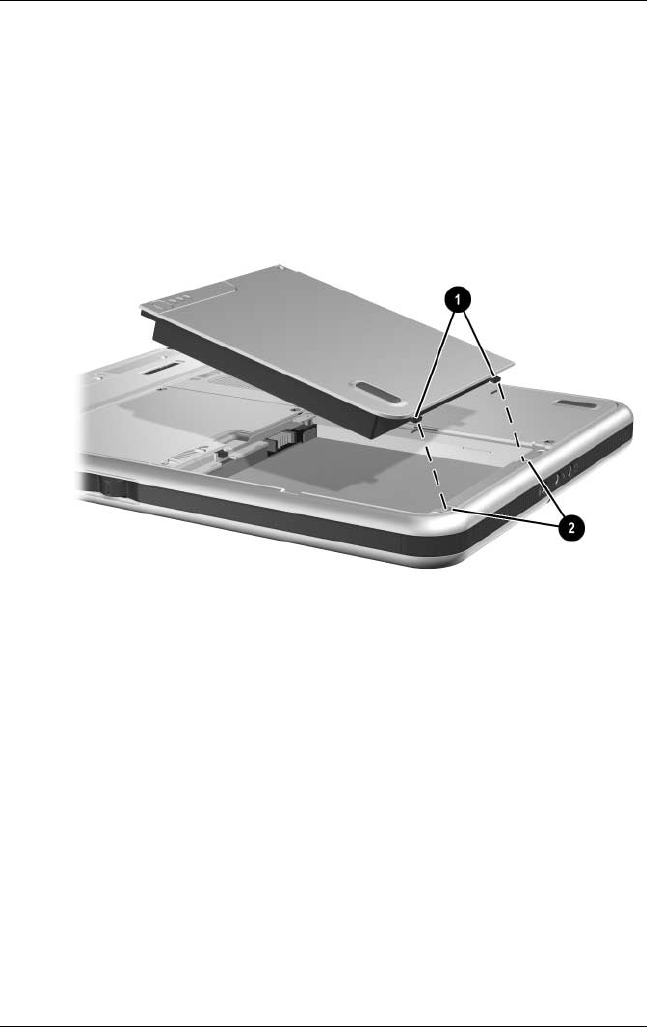
3–4 Hardware Guide
Battery Packs
Inserting a Battery Pack
To insert a battery pack into the tablet PC:
1. Turn the tablet PC front side down.
2. Align the 2 rectangular tabs 1 on the battery pack with
the 2 rectangular alignment slots 2 in the battery bay.
Aligning the battery pack tabs with the battery bay alignment slots
331734-001.book Page 4 Monday, July 14, 2003 3:47 PM
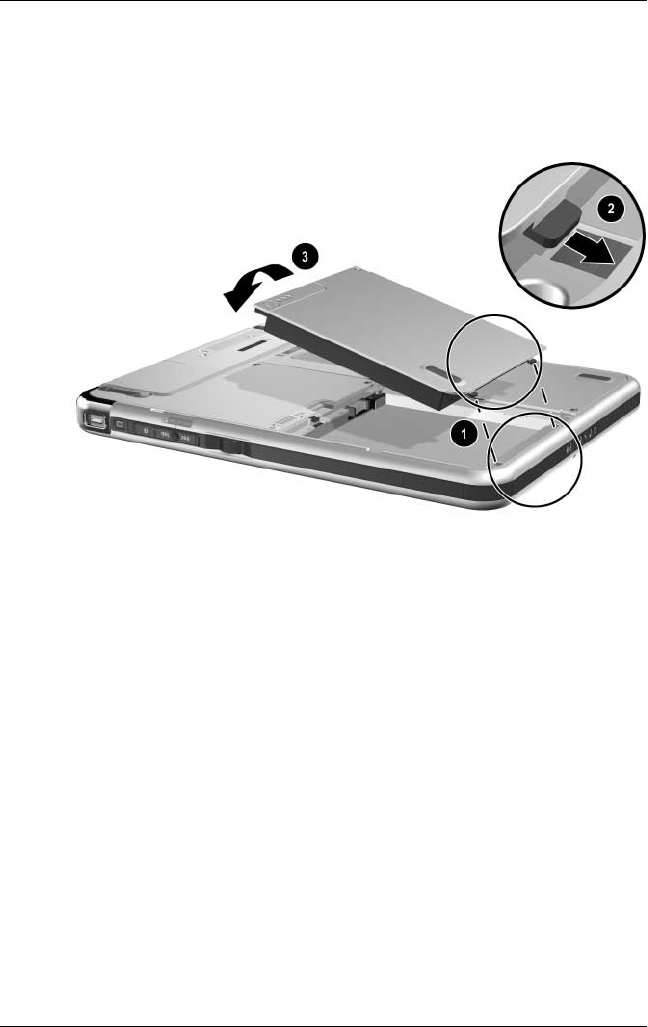
Battery Packs
Hardware Guide 3–5
3. Angle the battery pack toward the alignment slots 1 until
the 2 tabs are inserted into the 2 alignment slots 2.
4. Tilt the battery pack downward until it snaps into place 3.
Inserting a battery pack
5. If you initiated Standby or Hibernation before replacing the
battery pack, slide and release the power switch to resume
from Standby or Hibernation.
331734-001.book Page 5 Monday, July 14, 2003 3:47 PM
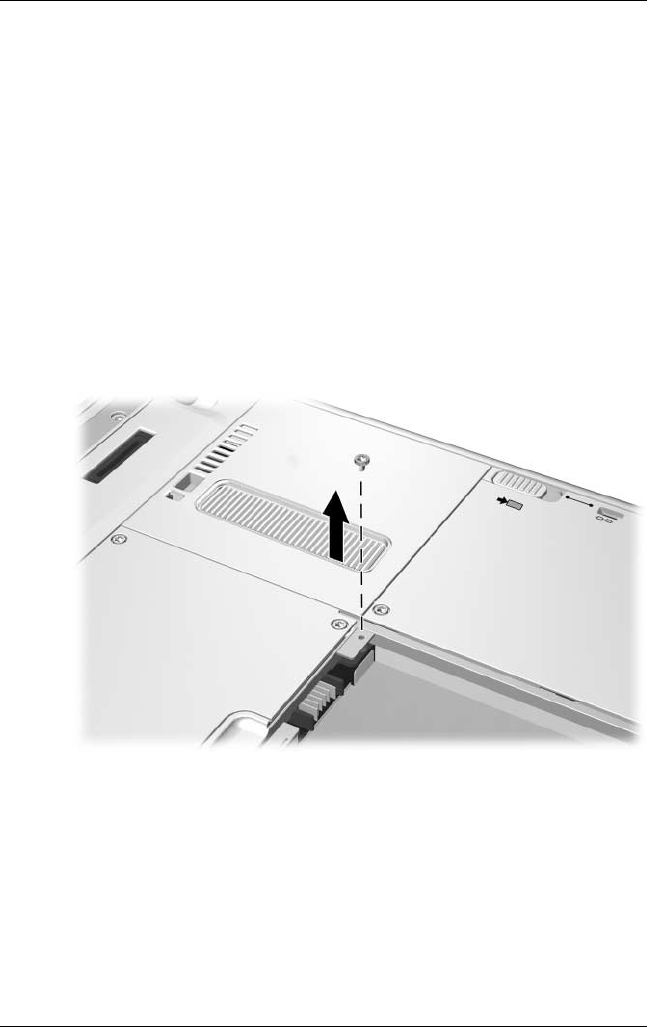
3–6 Hardware Guide
Battery Packs
Securing a Battery Pack
Use the battery pack security screw to hold the battery pack in
place, and to provide antitheft protection for the battery pack.
Accessing the Battery Pack Security Screw
A battery pack security screw ships inside the battery bay.
To access the battery pack security screw:
1. Remove the battery pack as instructed in “Removing a
Battery Pack” earlier in this section.
2. Remove the battery pack security screw.
Removing the battery pack security screw
331734-001.book Page 6 Monday, July 14, 2003 3:47 PM
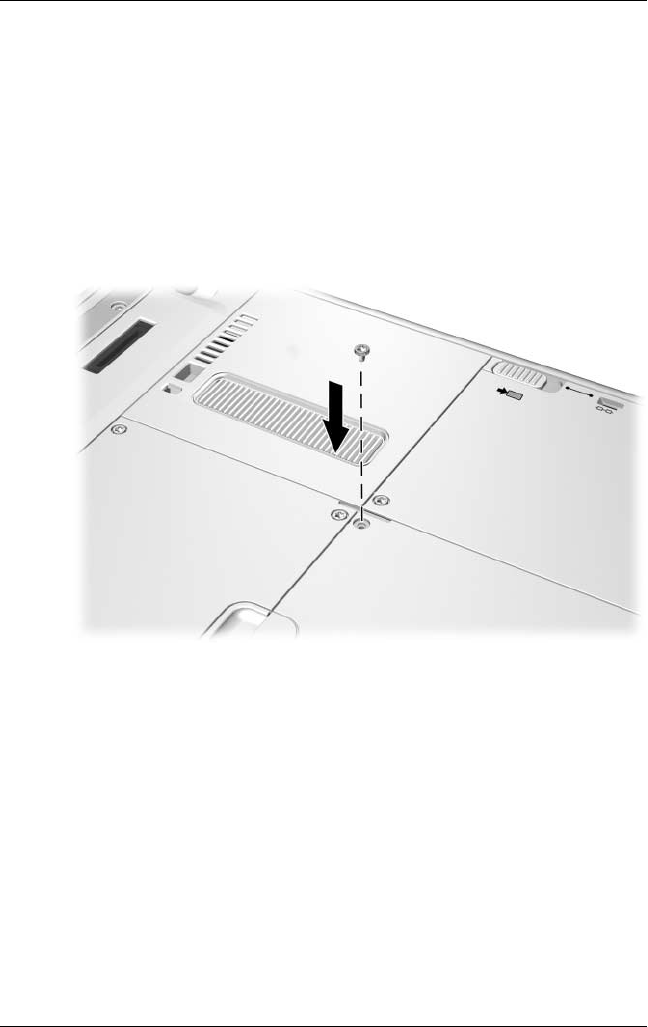
Battery Packs
Hardware Guide 3–7
Inserting a Battery Pack Security Screw
To secure the battery pack in the battery bay with a battery pack
security screw:
1. Insert the battery pack into the battery bay as instructed in
“Inserting a Battery Pack” earlier in this section.
2. Insert a battery pack security screw through the battery pack
case and into the tablet PC.
Inserting a battery pack security screw
331734-001.book Page 7 Monday, July 14, 2003 3:47 PM
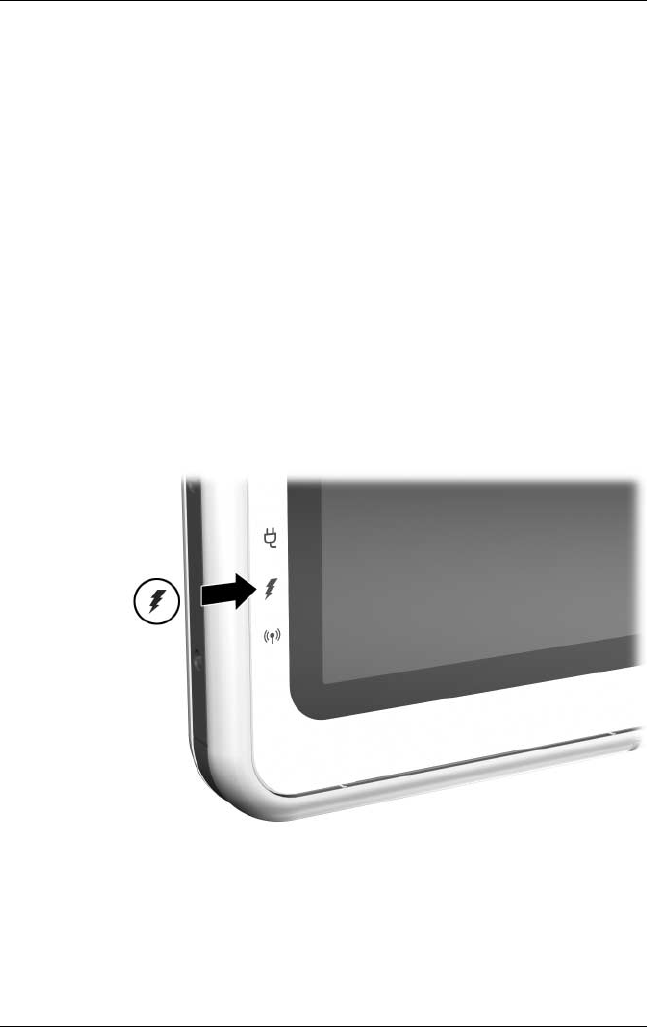
3–8 Hardware Guide
Battery Packs
Charging a Battery Pack
The battery pack in the tablet PC charges whenever the tablet PC
is connected to external power.
The battery pack charges whether or not the tablet PC is in use,
but charges faster when the tablet PC is off.
Charging may be delayed if a battery pack is new, has not been
used for 2 weeks or more, or is much warmer or cooler than
room temperature. Charging times vary.
The battery light displays charge status:
■On: the battery pack is charging.
■Off: the battery pack is fully charged.
■Flashing: the battery pack has 5 percent or less of a full
charge.
Identifying the battery light
331734-001.book Page 8 Monday, July 14, 2003 3:47 PM

Battery Packs
Hardware Guide 3–9
Charging a New Battery Pack
Fully charge the battery pack while the tablet PC is connected to
external power through the AC adapter.
A new battery pack that has been partially charged, but not fully
charged, can run the tablet PC, but battery charge displays may be
inaccurate.
Charging an In-Use Battery Pack
To prolong battery life and increase the accuracy of battery
charge displays:
■Allow the battery pack to discharge to less than 10 percent of
a full charge through normal use before charging it.
■When you charge the battery pack, charge it fully. An in-use
battery pack can be charged while the tablet PC is connected
to external power through the AC adapter or an optional
Automobile Power Adapter Charger, Docking Station, or
DC cable.
An optional Auto/Air Cable can be used to run the tablet PC, but
cannot be used to charge a battery pack.
331734-001.book Page 9 Monday, July 14, 2003 3:47 PM

3–10 Hardware Guide
Battery Packs
Monitoring the Charge in a
Battery Pack
Obtaining Accurate Charge Information
To increase the accuracy of all battery charge displays:
■Allow a battery pack to discharge to less than 10 percent of
a full charge through normal use before charging it.
■When you charge a battery pack, charge it fully.
■If a battery pack has not been used for one month or more,
calibrate the battery pack instead of simply charging it.
For calibration instructions, see “Calibrating a Battery Pack”
later in this chapter.
Displaying Charge Information on the
Screen
Accessing Charge Displays
To display battery charge information on the screen, use the
operating system Power Meter feature.
To access Power Meter displays, use either of the following
methods:
■Select Start > Control Panel > Performance and Maintenance
icon > Power Options icon > Power Meter tab.
■Select the Power Meter icon in the system tray.
To display the Power Meter icon in the system tray:
1. Select Start > Control Panel > Performance and Maintenance
icon > Power Options icon > Advanced tab.
2. Select the Always Show Icon On The Taskbar check box.
3. Select the OK button.
4. If the icon is not displayed, select in the system tray the icon
for Show Hidden Icons.
331734-001.book Page 10 Monday, July 14, 2003 3:47 PM

Battery Packs
Hardware Guide 3–11
Interpreting Charge Displays
Power Meter displays battery charge status in both percent
and time:
■The percent indicates the amount of charge remaining in the
battery pack.
■The time indicates the approximate running time remaining
on the battery pack if the battery pack continues to provide
power at the current level. For example, the time remaining
will decrease if you start backing up to an SD Card and will
increase when the backup is complete.
A lightening bolt icon indicates that the battery pack is charging.
331734-001.book Page 11 Monday, July 14, 2003 3:47 PM
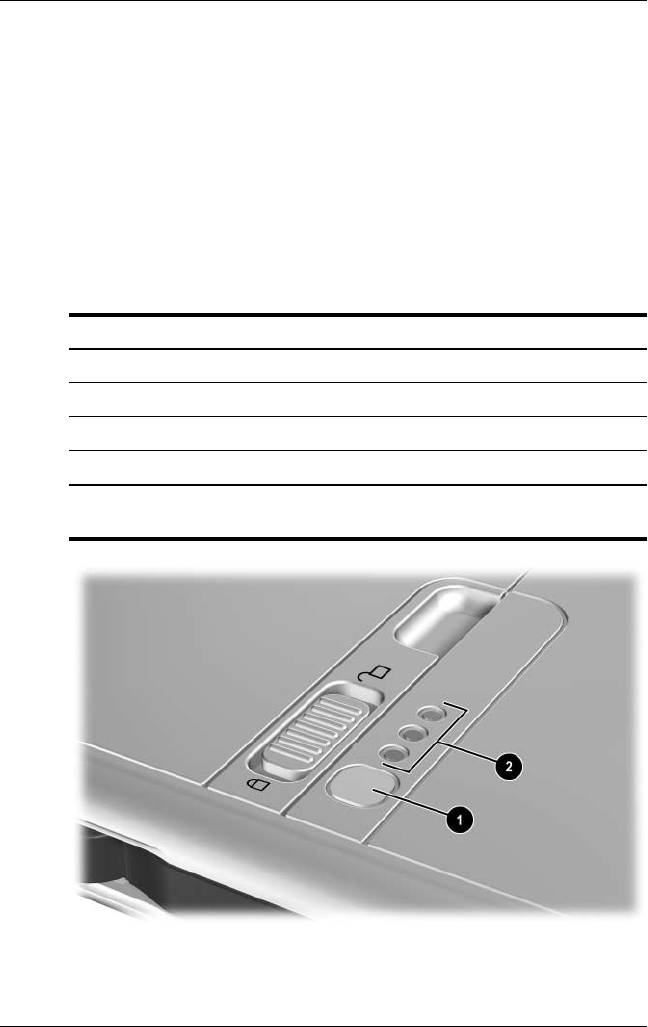
3–12 Hardware Guide
Battery Packs
Displaying Charge Information on a
Battery Pack
Charge information about a battery pack can be displayed on the
battery pack with the Quick Check feature, which can be used
whether or not the battery pack is inserted in the battery bay.
To display the percent of a full charge remaining in a battery
pack, press the battery quick check button 1 on the battery pack.
The three battery quick check lights 2 on the battery pack
indicate the charge remaining in the battery pack.
Identifying the quick check button and lights on a battery pack
inserted in the battery bay
Indication Percent of a Full Charge Remaining
3 lights on 67 to 100%
2 lights on 34 to 66%
1 light on 6 to 33%
1 light flashing* 0 to 5%
*When the battery pack reaches 5% of a full charge, the battery light on
the tablet PC also flashes.
331734-001.book Page 12 Monday, July 14, 2003 3:47 PM

Battery Packs
Hardware Guide 3–13
Managing Low-Battery Conditions
The information in this section describes default alerts and
system responses.
Some low-battery condition alerts and system responses can be
changed in the Power Options Properties window of the operating
system. Preferences set in the Power Options Properties window
do not affect lights.
For information about setting preferences in the Power Options
Properties window, refer on this CD to the Software Guide,
“Power” chapter, “Setting Power Preferences” section.
Identifying Low-Battery Conditions
Low-Battery Condition
When a battery pack that is the sole power source available to the
tablet PC reaches a low-battery condition (5 percent of a full
charge), the battery light flashes.
Critical Low-Battery Condition
If a low-battery condition is not resolved, the tablet PC enters a
critical low-battery condition (1 percent of a full charge).
In a critical low-battery condition:
■If Hibernation is enabled and the tablet PC is on or in
Standby, the tablet PC initiates Hibernation.
■If Hibernation is disabled and the tablet PC is on or in
Standby, the tablet PC remains briefly in Standby, then
shuts down and loses your unsaved work.
Hibernation is enabled by default. To verify that Hibernation
is enabled, select Start > Control Panel > Performance and
Maintenance icon > Power Options icon > Hibernate tab. If
Hibernation is enabled, the Enable Hibernation check box is
selected.
331734-001.book Page 13 Monday, July 14, 2003 3:47 PM
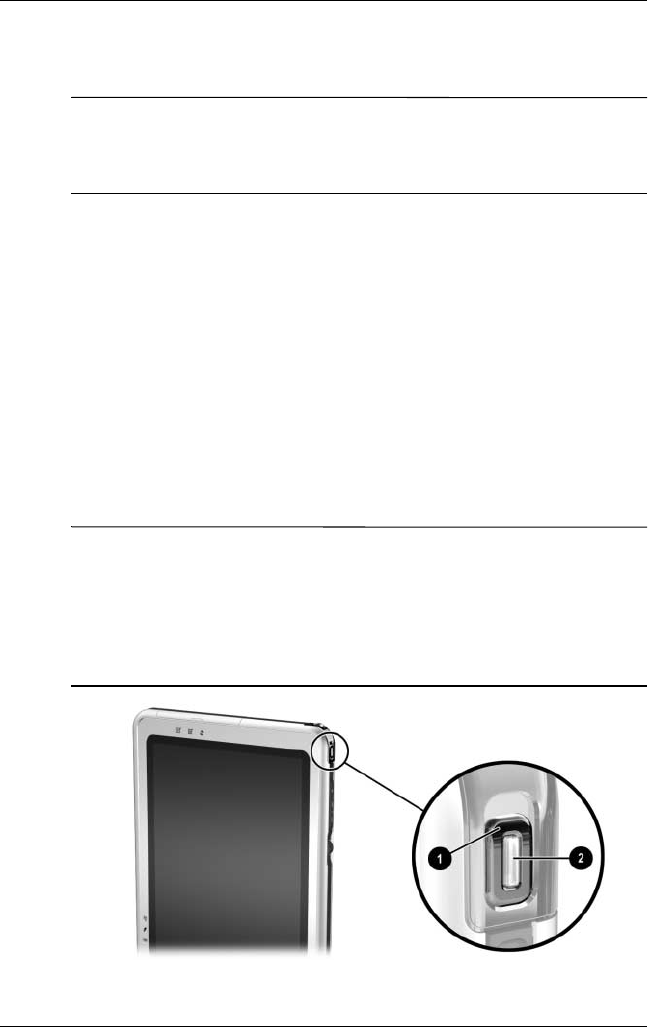
3–14 Hardware Guide
Battery Packs
Resolving Low-Battery Conditions
ÄCAUTION: If the tablet PC has reached a critical low-battery condition
(one percent of a full charge) and has initiated Hibernation, do not slide
the power switch until Hibernation is complete. Hibernation is complete
when the power/standby light turns off.
When a Charged Battery Pack Is Available
To resolve a low-battery condition, select one of the following
options:
■Turn off the tablet PC or initiate Hibernation, insert a charged
battery pack while the tablet PC is off or in Hibernation, then
turn on the tablet PC.
■To replace the battery with minimal disruption to your work,
slide and release the power switch 1 to initiate Standby,
confirm that Standby has been initiated by making sure the
power/standby light is flashing 2, then replace the battery
pack within one minute.
ÄCAUTION: To prevent loss of work, be sure to replace the battery pack
within one minute. The bridge battery runs the tablet PC in Standby for up
to one minute, at which point the tablet PC will shut down and lose
unsaved work if no external power is available.
Do not immediately repeat the Standby procedure for replacing a battery
pack. The bridge battery requires time to recharge between uses.
Identifying the power switch and the power/standby light
331734-001.book Page 14 Monday, July 14, 2003 3:47 PM

Battery Packs
Hardware Guide 3–15
When External Power Is Available
To resolve a low-battery condition, select one of the following
options:
■Plug the AC adapter cable into the tablet PC, then plug the
power cord into the AC adapter and into an AC electrical
outlet.
■Plug an optional Automobile Power Adapter/Charger into the
tablet PC and into a vehicle cigarette lighter receptacle.
■Plug an optional Auto/Air Cable into the tablet PC and into
the in-seat power supply available on some commercial
aircraft. (An optional Auto/Air Cable can run the tablet PC
but cannot charge a battery pack.)
When No Power Source Is Available
To resolve a low-battery condition, initiate Hibernation. Or, save
your work, then shut down the tablet PC.
Initiating and Resuming from Standby or
Hibernation
For more information about Standby and Hibernation, refer on
this CD to the Software Guide, “Power” chapter.
■To initiate Standby, slide and release the power switch. To
resume from Standby, slide and release the power switch.
■To initiate Hibernation, select Start >Turn off Computer >
Hibernate. If the Hibernate option is not displayed and an
external keyboard is attached, press and hold shift. (When you
press and hold shift, the Hibernate option replaces the Standby
option in the Shut Down window.) To resume from
Hibernation, slide and release the power switch.
For information about initiating Standby or Hibernation from the
Q Menu, refer on this CD to the Software Guide, “Q Menu and
Desktop Video Profiles” chapter.
331734-001.book Page 15 Monday, July 14, 2003 3:47 PM

3–16 Hardware Guide
Battery Packs
Calibrating a Battery Pack
When to Calibrate
Calibrate an in-use battery pack whenever battery charge displays
seem inaccurate or whenever the battery pack has not been used
for one month or more. It should not be necessary to calibrate any
battery pack, even if it is heavily used, more than once a month. It
is not necessary to calibrate a new battery pack before first use.
How to Calibrate
Calibration requires three steps:
■“Charging the Battery Pack”
■“Discharging the Battery Pack”
■“Recharging the Battery Pack”
To initiate an unattended calibration in an optional Battery
Charger or Multibattery Charger, follow the instructions included
with the charger.
To calibrate a battery pack manually, follow the instructions in
the following sections.
Charging the Battery Pack
You can charge the battery pack while the tablet PC is on or off,
but the battery pack will charge faster while the tablet PC is off.
To charge the battery pack:
1. Insert the battery pack into the tablet PC.
331734-001.book Page 16 Monday, July 14, 2003 3:47 PM

Battery Packs
Hardware Guide 3–17
2. Connect the tablet PC to external power. (The battery light
turns on.) To connect the tablet PC to external power, use any
of the following methods:
❏Plug the AC adapter cable into the tablet PC, then plug
the power cord into the AC adapter and into an
AC electrical outlet.
❏Plug an optional Automobile Power Adapter/Charger
into the tablet PC and into a vehicle cigarette lighter
receptacle.
3. Leave the tablet PC connected to external power until the
battery pack is fully charged. (The battery light turns off.)
Discharging the Battery Pack
The tablet PC must remain on while the battery pack is being
discharged. The battery pack can discharge whether or not you
are using the tablet PC, but will discharge faster while the
tablet PC is in use.
■If you plan to leave the tablet PC unattended during the
discharge, save your work before beginning the discharge
procedure.
■If you use the tablet PC occasionally during the discharge
procedure and have set energy-saving timeouts, expect the
following performance from your system during the
discharge process:
❏The monitor will not turn off automatically.
❏Hard drive speed will not decrease automatically while
the tablet PC is idle.
❏System-initiated Standby will not occur.
❏System-initiated Hibernation will not occur until the
battery has discharged to a critical low-battery condition.
331734-001.book Page 17 Monday, July 14, 2003 3:47 PM

3–18 Hardware Guide
Battery Packs
To fully discharge a battery pack:
1. When the battery light turns off indicating that the
battery pack is fully charged, select Start > Control Panel >
Performance and Maintenance icon > Power Options icon >
Power Schemes tab.
2. Record the 2 settings in the Plugged In column and the
2 settings in the Running On Batteries column so that you
can reset them after the calibration.
3. Change the settings in both columns to Never.
4. Select the OK button.
5. Disconnect the tablet PC from the external power source, but
do not turn off the tablet PC.
6. Run the tablet PC on battery power until the battery pack is
fully discharged. (The battery light begins to flash when the
battery pack has discharged to a low-battery condition. When
the battery pack is fully discharged, the tablet PC initiates
Hibernation and the power/standby light turns off.)
Recharging the Battery Pack
1. Connect the tablet PC to external power, then leave the
tablet PC connected to external power until the battery pack
is fully recharged. (The battery light turns off.)
You can use the tablet PC while the battery pack is recharging
but the battery pack will charge faster if the tablet PC is off.
2. If the tablet PC is off, turn it on when the battery pack is fully
charged and the battery light turns off.
3. Select Start > Control Panel > Performance and Maintenance
icon > Power Options icon > Power Schemes tab.
4. Referring to the settings you recorded earlier, reenter your
settings for the 2 options in the Plugged In column and
the 2 options in the Running On Batteries column.
5. Select the OK button.
331734-001.book Page 18 Monday, July 14, 2003 3:47 PM

Battery Packs
Hardware Guide 3–19
Battery Conservation Procedures and
Settings
Using the battery conservation procedures and settings described
in the following sections extends the time that a battery pack can
run the tablet PC from a single charge.
Conserving Power as You Work
To conserve power as you use the tablet PC:
■Turn off wireless and local area network (LAN) connections
and exit modem applications when you are not using them.
■Detach, disconnect, stop, or remove unpowered external
devices that you are not using. Such devices include a
PC Card, an SD Card, or a tablet PC keyboard.
■Use the Brightness item on the Q Menu to lower and raise
screen brightness quickly.
■Use optional powered speakers instead of the internal
speakers, or use volume controls to mute, restore, raise, and
lower system volume quickly.
■If you leave your work, initiate Standby or Hibernation or
shut down the tablet PC.
Selecting Power Conservation Settings
To set the tablet PC to conserve power:
■Select a short wait for the screen saver and select a screen
saver with minimal graphics and motion. To access screen
saver settings, select Start > Control Panel > Appearance and
Themes icon > Display icon > Screen Saver tab.
■Follow the instructions on this CD in the Software Guide,
“Power” chapter, to select a power scheme with low
power-use settings.
331734-001.book Page 19 Monday, July 14, 2003 3:47 PM

3–20 Hardware Guide
Battery Packs
Storing a Battery Pack
If the tablet PC will be unused and unplugged for more than
one month, remove and store the battery pack.
ÄCAUTION: To prevent damage to a battery pack, do not expose it to
high temperatures for extended periods of time.
High temperatures accelerate the self-discharge rate of a stored
battery pack. To prolong the charge of a stored battery pack, place
it in a cool, dry place.
Use the following table to estimate how long you can safely store
a battery pack. The storage times provided are based on a battery
pack that contains 50 percent of a full charge. A fully charged
battery pack can be safely stored for longer; a battery pack
containing a low charge can be safely stored for less time.
Calibrate a battery pack that has been stored for one month or
more before using it.
At These Temperatures
You Can Safely Store a Battery
Pack for This Amount of Time
Temperature
Range °F
Temperature
Range °C Storage Time
115°–140° 46°–60° Less than 1 month
79°–113° 26°–45° No more than 3 months
32°–77° 0°–25° 1 year
331734-001.book Page 20 Monday, July 14, 2003 3:47 PM

Battery Packs
Hardware Guide 3–21
Disposing of a Used Battery Pack
ÅWARNING: There is a risk of fire and chemical burn if a battery pack
is handled improperly. Do not disassemble, crush, or puncture a battery
pack or short the contacts on a battery pack. Do not expose a battery
pack to temperatures higher than 60° C (140° F), or dispose of a
battery pack in water or fire.
When a battery pack has reached the end of its useful life, do not
dispose of it in general household waste.
■In North America, you can dispose of battery packs by using
the HP battery recycling program. This program provides you
with a postage-paid battery pack mailer preaddressed to a
reclamation facility where the metals are recycled. For more
information, call the telephone number listed for your
location in the Worldwide Telephone Numbers booklet,
included in English only with the tablet PC.
■In Europe, dispose of or recycle battery packs by using the
public collection system or by returning them to HP, your
authorized HP partners, or their agents.
■In other regions, refer to the Worldwide Telephone Numbers
booklet, included in English only with the tablet PC, to
contact an HP-authorized dealer, reseller, or service provider
and request information about battery pack disposal.
For more information about battery pack precautions and disposal
and the complete text of governmental agency notices, refer on
this CD to the Regulatory and Safety Notices guide.
Finding More Power Information
For more information about using Standby and Hibernation,
conserving power, setting power preferences, and using other
power management features, refer on this CD to the Software
Guide, “Power” chapter. For information about initiating Standby
or Hibernation from the Q Menu, refer in the Software Guide to
the “Q Menu and Desktop Video Profiles” chapter.
331734-001.book Page 21 Monday, July 14, 2003 3:47 PM

Hardware Guide 4–1
4
Drives
Adding a Drive to the System
Drives enable you to store and access data.
A standard removable drive can be added to the system by
inserting the drive into the MultiBay of an optional External
MultiBay or Docking Station. A USB drive can be added by
connecting the drive to a USB connector on the tablet PC or on
the Docking Station. Hard drive functions can also be added with
aPCCard.
For information about connecting a USB drive, see Chapter 8,
“External Device Connections.” For information about PC Cards,
see Chapter 9, “Additional Hardware Options.” For general
information about inserting and removing drives from an External
MultiBay or Docking Station, refer to the documentation
included with the device.
This chapter provides specific information about using drives in
the tablet PC system.
The tablet PC hard drive bay supports only a 9.5-mm system hard
drive. A MultiBay in an External MultiBay or Docking Station
supports an additional 9.5-mm optional hard drive (inserted in
a MultiBay Hard Drive Adapter) and the following 12.7-mm
standard removable drives:
❏CD-ROM drive ❏DVD/CD-RW drive
❏CD-RW drive ❏Diskette drive
❏DVD-ROM drive
331734-001.book Page 1 Monday, July 14, 2003 3:47 PM

4–2 Hardware Guide
Drives
Understanding Drive Terms
Terms for Types of Drives
A hard drive is used for the permanent storage of data files and of
software such as system files, applications, and drivers. The hard
drive in the hard drive bay is the system hard drive, sometimes
called the local disk. The system hard drive can be replaced, but
cannot be used in a MultiBay. A hard drive is sometimes called a
hard disk drive or HDD.
Diskette drives are often used to store or transport data. The
tablet PC can read or write to any MultiBay diskette drive. A
diskette drive is sometimes called a floppy disk drive, floppy
drive, or FDD.
Optical drives include CD and DVD drives. Optical drives are
used to store or transport data and to play music and movies.
DVD media have higher capacities than CD media. The
tablet PC can read or write to optical drives as described in the
following table.
Terms for Drive Media
A diskette or disc that can be inserted or removed from a drive is
referred to as a drive medium. In this guide a diskette is inserted
in a diskette drive, and a disc is inserted in an optical drive.
Optical Drive Read Write
CD-ROM drive Yes No
CD-RW drive Yes Yes
DVD-ROM drive Yes No
DVD/CD-RW drive Yes Yes
331734-001.book Page 2 Monday, July 14, 2003 3:47 PM

Drives
Hardware Guide 4–3
Caring for Drives
Drives are fragile system components that must be handled with
care. Observe the following cautions when handling any drive.
ÄCAUTION: To prevent damage to the tablet PC or a drive and loss
of work:
■Do not remove the system hard drive except for repair or
replacement. For instructions, see Chapter 10, “Maintenance,
Shipping and Travel.”
■Electrostatic discharge can damage electronic components.
To prevent electrostatic damage to the tablet PC or a drive, follow
these 2 precautions: (1) Discharge yourself from static electricity
before handling a drive by touching a grounded metal object and
(2) Avoid touching the connectors on a drive. For more information
about preventing electrostatic damage, refer on this CD to the
Regulatory and Safety Notices guide.
■Excessive force can damage drive connectors. When you insert a
drive, use only enough force to seat the drive.
■Handle a drive carefully. Do not drop it.
■Avoid exposing a hard drive or a diskette to devices with magnetic
fields. Products with magnetic fields include video and audio tape
erasure products, monitors, and speakers. Security devices with
magnetic fields include airport walk-through devices and security
wands. The airport security devices that check carry-on luggage,
usually while it is placed on a conveyor belt, use x-rays instead of
magnetism and will not damage a hard drive or a diskette.
■Do not spray a drive with cleaners.
■Avoid exposing a drive to liquids or temperature extremes.
■If you mail a drive, ship it in packaging that protects it from shock,
vibration, temperature, and humidity. Label the package
“FRAGILE.”
331734-001.book Page 3 Monday, July 14, 2003 3:47 PM
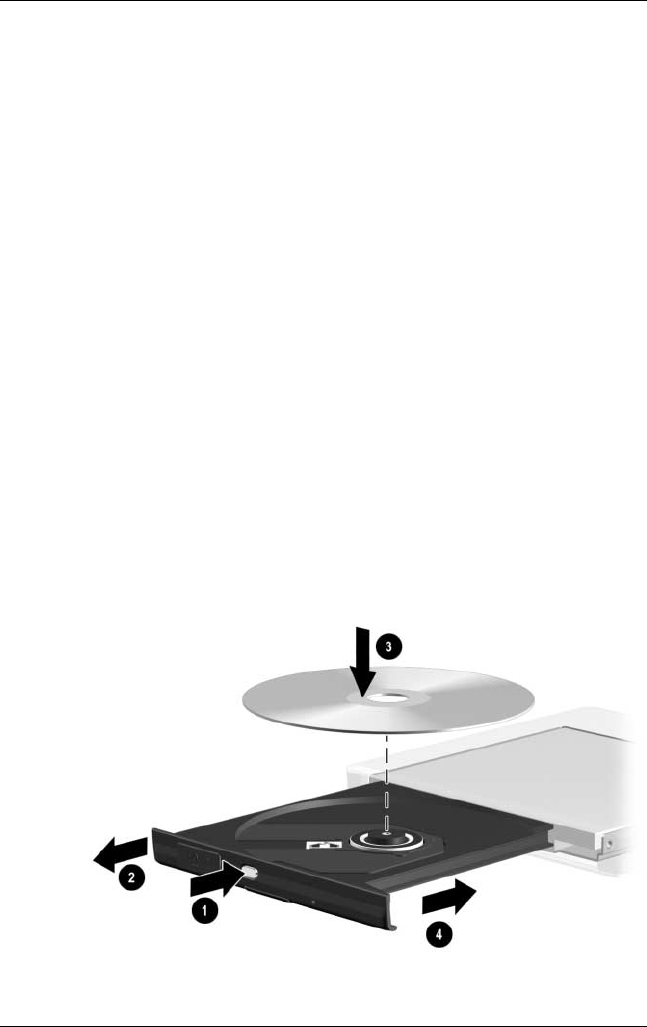
4–4 Hardware Guide
Drives
Inserting or Removing Drive Media
For general information about inserting or removing a drive from
a MultiBay, refer to the documentation included with an optional
External MultiBay or Docking Station. This section provides
information that is not provided with optional drives or
MultiBays and that may be helpful to users unfamiliar with
standard removable drives.
Inserting a CD or DVD
1. Be sure the tablet PC is turned on.
2. Press the media release button 1 on the drive bezel to release
the media tray, then pull the tray outward until it is fully
extended 2.
3. Position a CD or one-sided DVD over the tray label side up.
4. Gently press the disc onto the tray spindle 3 until the disc
snaps into place. Handle the disc by the edges, not the flat
surfaces. (If the media tray is not fully extended, tilt the disc
to position it over the tray spindle, then press it downward
into position.)
5. Close the media tray 4.
Inserting a CD or DVD into an optical drive
331734-001.book Page 4 Monday, July 14, 2003 3:47 PM
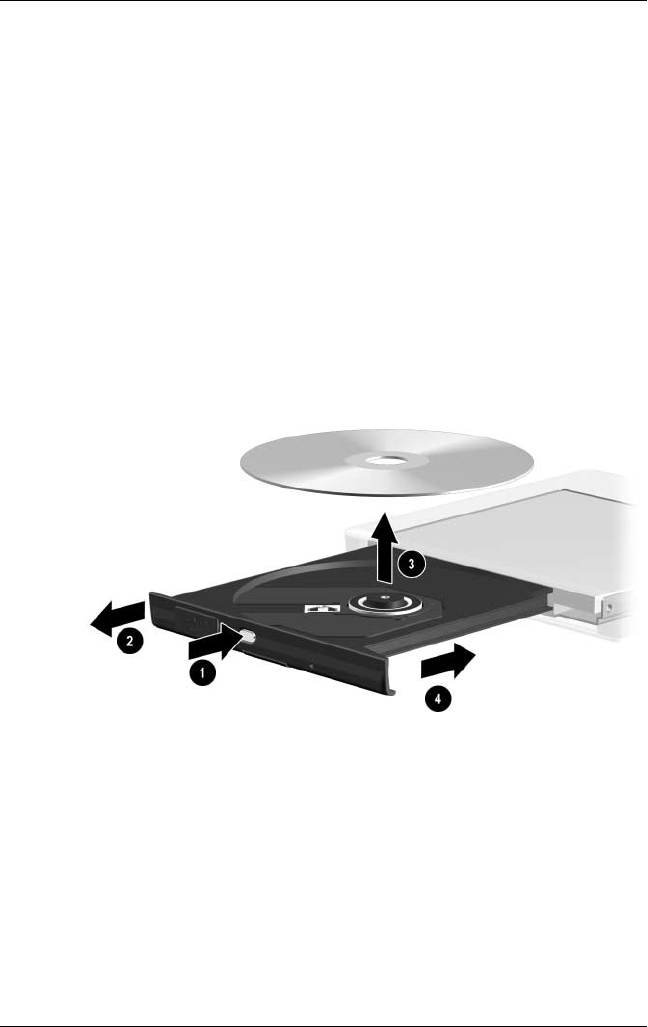
Drives
Hardware Guide 4–5
Removing a CD or DVD (with Power)
If power is available:
1. Be sure the tablet PC is on.
✎Press the media release button 1 on the drive bezel to release the
media tray, then pull the tray outward until it is fully extended 2.
2. Remove the disc from the tray 3 by gently pushing down
on the spindle while pulling up on the outer edges of the disc.
If the media tray is not fully extended, tilt the disc as you
remove it. Handle the disc by the edges, not the flat surfaces.
3. Close the media tray 4.
4. Place the disc in a protective case.
Removing a CD or DVD from an optical drive when power
is available
331734-001.book Page 5 Monday, July 14, 2003 3:47 PM
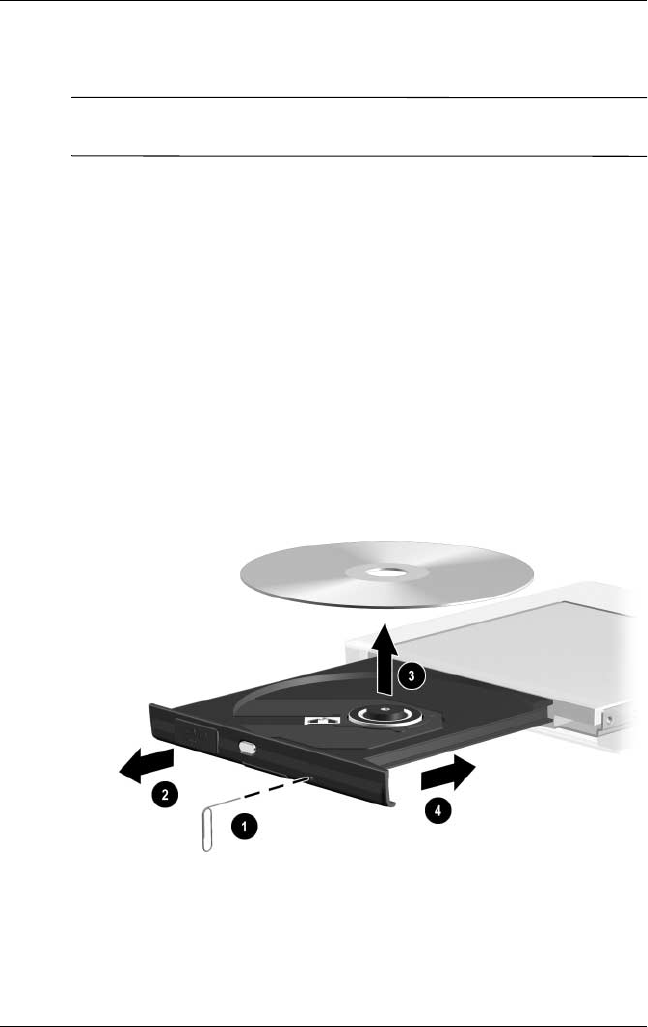
4–6 Hardware Guide
Drives
Removing a CD or DVD (Without Power)
ÄCAUTION: To prevent damage to the pen tip, do not insert the pen tip
into the release access.
If the tablet PC is turned off or if no power is available, the media
release button on the drive will not work. To remove a disc from
an optical drive without using the media release button:
1. Insert a small object like the end of a paper clip into the
release access 1 in the front bezel of the drive.
2. Press gently on the paper clip until the media tray is released,
then pull the tray outward until it is fully extended 2.
3. Remove the disc from the tray 3. If the media tray is not fully
extended, tilt the disc as you remove it. Handle the disc by the
edges, not the flat surfaces.
4. Close the media tray 4.
5. Place the disc in a protective case.
Removing a CD or DVD from an optical drive when power is not
available
331734-001.book Page 6 Monday, July 14, 2003 3:47 PM
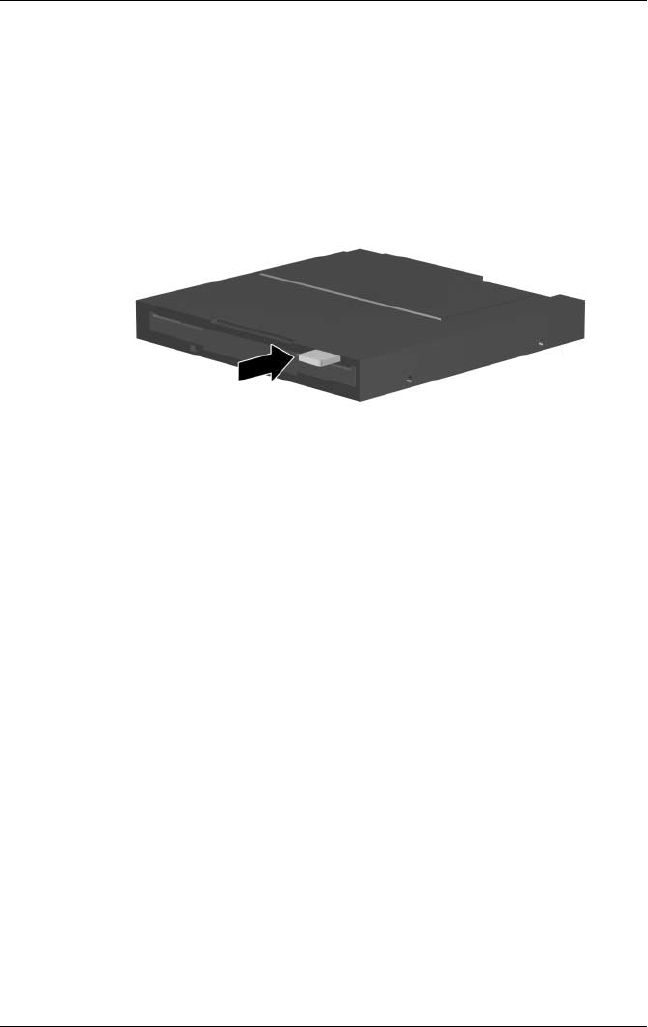
Drives
Hardware Guide 4–7
Inserting a Diskette
To insert a diskette into a diskette drive, gently push the diskette,
label side up, into the drive until it clicks into place.
The media eject button extends when the diskette is correctly
inserted.
Identifying the media eject button on a diskette drive
Removing a Diskette
To remove a diskette from a diskette drive:
1. Press the media eject button on the drive to eject the diskette.
2. Pull the diskette from the drive.
3. Place the diskette in a protective case.
331734-001.book Page 7 Monday, July 14, 2003 3:47 PM

4–8 Hardware Guide
Drives
Using Drive Media
Avoiding Standby and Hibernation
✎Initiating Standby or Hibernation while playing audio or video
drive media may stop the play or diminish the quality of the play.
If Standby or Hibernation is accidentally initiated while a
medium is in use, slide and release the power switch to resume
from Standby or Hibernation, then restart the tablet PC.
For more information about Standby and Hibernation, refer on
this CD to the Software Guide, “Power” chapter.
Displaying Media Contents
When you insert a diskette, CD, or DVD into the system, the
tablet PC can play the medium, display its contents, take no
action, or display a response prompt on the screen. You can set
the responses of the tablet PC to the insertion of various types of
media by using the operating system AutoPlay feature.
Setting AutoPlay Preferences
To set AutoPlay preferences:
1. Select Start > My Computer.
2. Right-click a drive.
3. Select Properties > AutoPlay tab, then follow the instructions
on the screen.
4. To save your settings, select the OK button.
331734-001.book Page 8 Monday, July 14, 2003 3:47 PM

Drives
Hardware Guide 4–9
Displaying Media Contents Without Using AutoPlay
To display the contents of a drive medium when the contents are
not displayed by AutoPlay:
1. Insert the medium into the drive.
2. Select Start > Run, then type:
explorer x:
(where X = the drive designation of the drive containing
the medium).
3. Select the OK button.
✎A drive designation is a letter of the alphabet that the tablet PC
uses to identify the drive. To display the drive designation of
every drive in the system, select Start > My Computer.
Caring for Drive Media
ÄCAUTION: To prevent damage to drive media:
■Do not open the metal shutter of a diskette or touch the disk within
the diskette case.
■Do not expose a diskette to a strong magnetic field, such as the
security field used by a walk-through security device or a handheld
security wand.
■Clean a CD or DVD only with a disc cleaning kit. Disc cleaning kits
are available from most electronics retailers.
\\
331734-001.book Page 9 Monday, July 14, 2003 3:47 PM

4–10 Hardware Guide
Drives
Finding More Drive Software
Information
All the software you need to play the types of CDs and DVDs
supported by the tablet PC is included with the tablet PC. For
information about this software, refer on this CD to the Software
Guide, “CD and DVD Software” chapter.
In addition, a feature in the Setup utility enables you to set the
tablet PC to start from a specified medium or device. For
instructions, refer on this CD to the Software Guide, “Boot
Order” chapter.
331734-001.book Page 10 Monday, July 14, 2003 3:47 PM

Hardware Guide 5–1
5
Audio
Adjusting Volume
Volume can be adjusted by using the Windows volume control
icon, the Q Menu, or the volume adjustment available within
some applications. Volume can be adjusted on the Q Menu
without using a keyboard or the pen. For information about
application volume features, refer to the application
documentation.
Using the Volume Control Icon
To display the Windows volume control icon in the system tray:
1. Select Start > Control Panel > Sounds, Speech, and Audio
Devices icon > Sounds and Audio Devices icon.
2. Select the Volume tab.
3. Select the check box for Place Volume Icon In The Taskbar.
4. Select the OK button.
5. If the icon is not displayed, select the system tray icon for
Show Hidden Icons.
To adjust, mute, or restore volume using the volume control icon,
select the icon in the system tray. Then:
■To increase or decrease volume, select the slide bar, then drag
it upward or downward.
■
To mute or restore volume, select or clear the Mute check box.
To close the volume control pop-up window, click anywhere
outside the window.
331734-001.book Page 1 Monday, July 14, 2003 3:47 PM
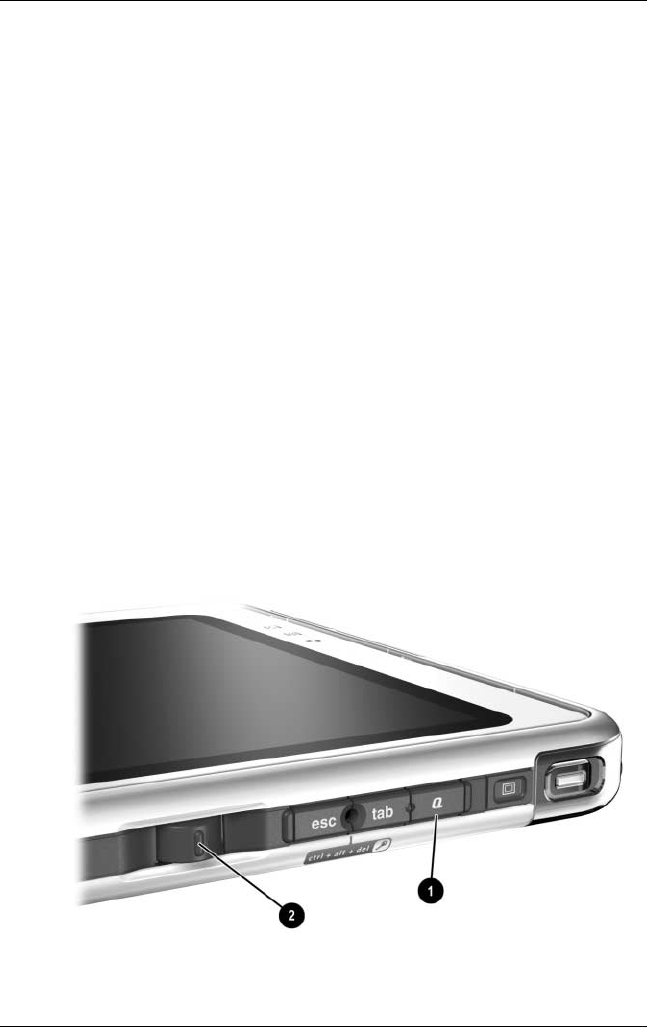
5–2 Hardware Guide
Audio
Using the Q Menu
To adjust, mute, or restore volume using the Q Menu:
1. To open the Q Menu, press the Q menu button 1.
❏To display the Windows volume control window, select
the Volume tab.
❏To mute or restore system volume, select the Mute
On/Off tab. (Selecting the On/Off tab mutes system
volume if it is on or restores system volume if it
is muted.)
2. To close the Q Menu, press the Q menu button, tap anywhere
outside the Q Menu with the pen tip, or click an optional
pointing device.
To select an item on the Q Menu without using a keyboard or the
pen, press the Q menu button, rotate the jog dial 2 upward or
downward to scroll vertically through the items, then press the
jog dial inward to select an item.
For more information about using the Q Menu, refer on this CD
to the Software Guide, “Q Menu and Desktop Video Profiles”
chapter.
Identifying the Q menu button and the jog dial
331734-001.book Page 2 Monday, July 14, 2003 3:47 PM
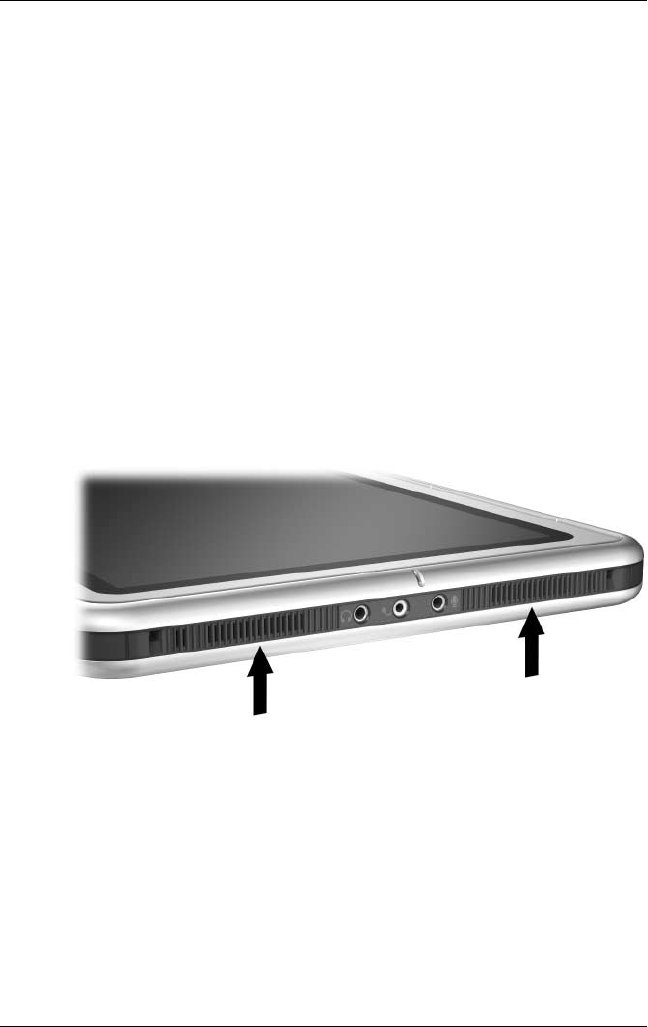
Audio
Hardware Guide 5–3
Using the Internal Speakers
The internal speakers play sound in stereo from applications,
the operating system, games, drive media, the Internet, and other
sources.
The internal speakers are disabled if:
■Optional powered speakers or a headphone is connected to
the audio-out jack on the tablet PC or an optional Docking
Station.
■An optional mobile telephone headset is connected to the
headset jack.
Attaching an optional tablet PC keyboard to the tablet PC or
connecting a line-in device, such as a clock radio or MP3 player,
to the tablet PC or to an optional Docking Station does not affect
the performance of the internal speakers.
Identifying the internal speakers
331734-001.book Page 3 Monday, July 14, 2003 3:47 PM
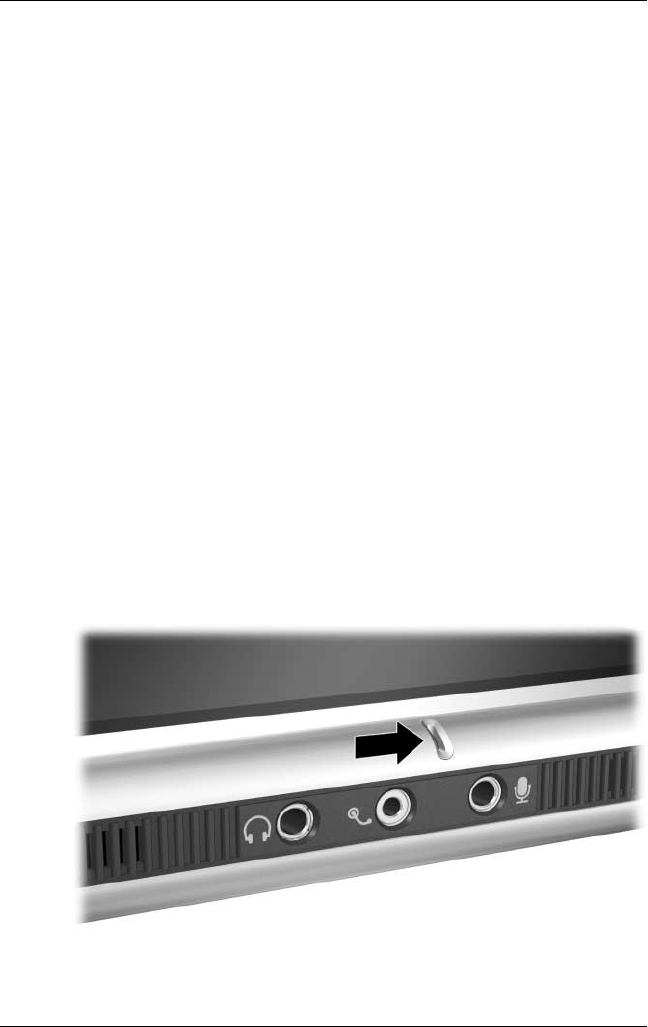
5–4 Hardware Guide
Audio
Using the Internal Microphone
The internal microphone:
■Has a standard sensitivity of -45 decibels.
■Can be used while a screen protector or an optional tablet PC
keyboard is attached. A screen protector is provided with an
optional Docking Station.
■Is disabled if:
❏An optional external microphone is connected to the
microphone jack.
❏An optional headset is connected to the headset jack.
If you are using speech recognition or other software that requires
optimal sound quality, use an optional external microphone or
headset. To access on-screen tutorials that include operating
system speech features:
1. Open Windows Explorer. To open Windows Explorer from
the Start button, select Start > All Programs > Accessories >
Windows Explorer.
2. In Windows Explorer, select My Computer > Local
Disk (C:) > WINDOWS > Help > latute.hta.
Identifying the internal microphone
331734-001.book Page 4 Monday, July 14, 2003 3:47 PM
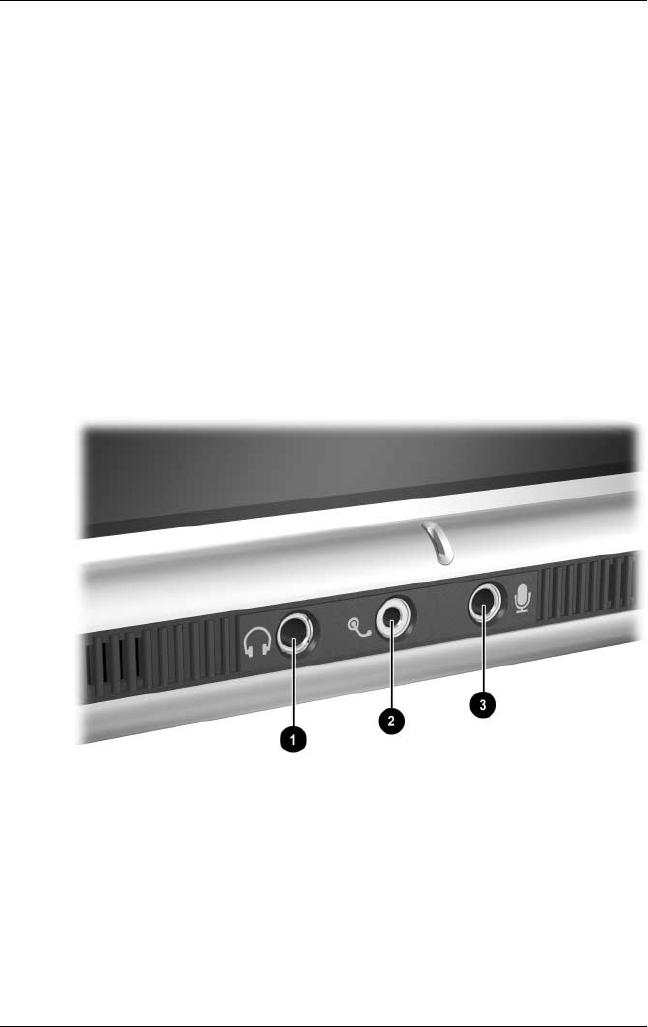
Audio
Hardware Guide 5–5
Connecting an Audio Device
Identifying Audio Jacks
The tablet PC has 3 audio jacks:
■The audio-out jack 1 connects stereo headphones or powered
stereo speakers.
■The headset jack 2 can support a headset, such as a mobile
telephone headset with a microphone and a monaural ear
piece.
■The microphone jack 3 supports a monaural external
microphone.
Identifying the audio jacks
331734-001.book Page 5 Monday, July 14, 2003 3:47 PM

5–6 Hardware Guide
Audio
Using the Audio-Out Jack
ÅWARNING: To reduce the risk of personal injury, adjust the volume
before putting on headphones.
ÄCAUTION: To prevent possible damage to an external device, do not
plug a monaural plug into the audio-out jack.
When connecting a device to the audio-out jack:
■Use only a 3.5-mm stereo plug.
■For best sound quality, use 24-ohm to 32-ohm headphones.
When optional powered speakers or a headphone is connected
to the audio-out jack on the tablet PC or an optional Docking
Station, the internal speakers are disabled.
Using the Headset Jack
The headset jack can support a headset, such as a mobile
telephone headset, that has a microphone, a monaural ear piece,
and a 2.5-mm plug.
When a headset is connected to the headset jack, the internal
microphone and speakers are disabled.
331734-001.book Page 6 Monday, July 14, 2003 3:47 PM

Audio
Hardware Guide 5–7
Using the Microphone Jack
The microphone jack supports a monaural microphone with a
3.5-mm plug.
A monaural electret condenser microphone is recommended. If
you connect a stereo microphone, left channel sound will record
on both channels.
When an optional headset or external microphone is connected to
the tablet PC, the internal microphone is disabled.
Finding Audio and Video
Software Information
For information about using audio and video software, refer on
this CD to the Software Guide, “CD and DVD Software” chapter.
331734-001.book Page 7 Monday, July 14, 2003 3:47 PM

Hardware Guide 6–1
6
Internal Modem
The tablet PC has an RJ-11 telephone jack and preinstalled
modem drivers.
A modem cable with RJ-11 connectors at each end is included
with models that ship with an internal modem. If you purchased
the tablet PC in a country where RJ-11 telephone jacks are not
standard, a country-specific modem adapter is also included.
The internal modem supports:
■All applications supported by the operating system.
■V.34 ITU (International Telecommunications Union) analog
modem recommendations for speeds up to 33.6 Kbps.
■V.44 data compression algorithm.
■V.90/V.92 ITU digital/analog modem pair recommendations
for speeds up to 56 Kbps.
✎The digital/analog modem pair rates allow faster
downloads only from compliant digital sources. Maximum
achievable download rates are currently unknown, may not
reach 56 Kbps, and will vary with line conditions. Maximum
achievable upload rates are limited to 48 Kbps, may not
reach 48 Kbps, and will vary with line conditions.
331734-001.book Page 1 Monday, July 14, 2003 3:47 PM

6–2 Hardware Guide
Internal Modem
Connecting the Modem
Selecting Connectors
The modem must be connected to an analog telephone line.
ÅWARNING: To reduce the risk of electric shock, fire, or damage to the
equipment, do not plug a telephone cable into the RJ-45 network jack.
ÄCAUTION: Jacks for digital PBX systems may resemble RJ-11 telephone
jacks, but are not compatible with the modem.
Jacks for analog telephone lines and procedures for connecting
the modem vary by country:
■If you are connecting the modem in a country where
RJ-11 telephone jacks are standard, follow the instructions
in the “Connecting the Modem to an RJ-11 Jack” section,
next in this chapter.
■If you are connecting the modem in a country where RJ-11
telephone jacks are not standard, a modem adapter specific to
the country in which you purchased the tablet PC is included
with the tablet PC. Follow the instructions in the “Connecting
the Modem with an Adapter” section, later in this chapter.
■If you plan to use the modem outside the country in which
you purchased the tablet PC, you can purchase adapters
specific for the countries on your itinerary from most
computer or electronics retailers. For information about
using country-specific software configurations, see the
“Setting Country Preferences” section, later in this chapter.
331734-001.book Page 2 Monday, July 14, 2003 3:47 PM
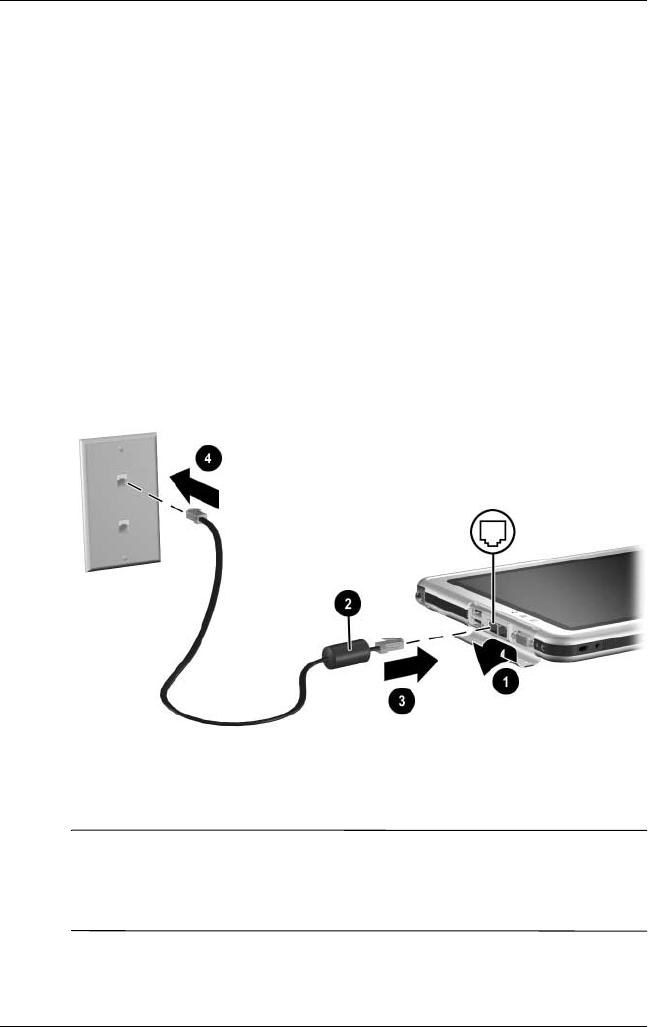
Internal Modem
Hardware Guide 6–3
Connecting the Modem to an RJ-11 Jack
To connect the modem to an analog telephone line that has an
RJ-11 telephone jack:
1. To access the RJ-11 jack 1 on the tablet PC, open the upper
panel of the tablet PC.
2. If the modem cable has noise suppression circuitry 2, which
prevents interference with TV and radio reception, orient the
circuitry end of the cable toward the tablet PC.
3. Plug the cable into the RJ-11 telephone jack 3 (not the
RJ-45 network jack) on the tablet PC.
4. Plug the modem cable into an RJ-11 telephone jack 4 (not
into an RJ-45 network jack or a PBX jack).
Connecting the modem to an RJ-11 telephone wall jack
(Telephone wall jacks vary in appearance by region.)
ÅWARNING: To reduce the risk of electric shock, disconnect the modem
from the telephone network before accessing an internal compartment
of the tablet PC. Internal compartments include the memory and
Mini PCI compartment and the hard drive bay.
331734-001.book Page 3 Monday, July 14, 2003 3:47 PM
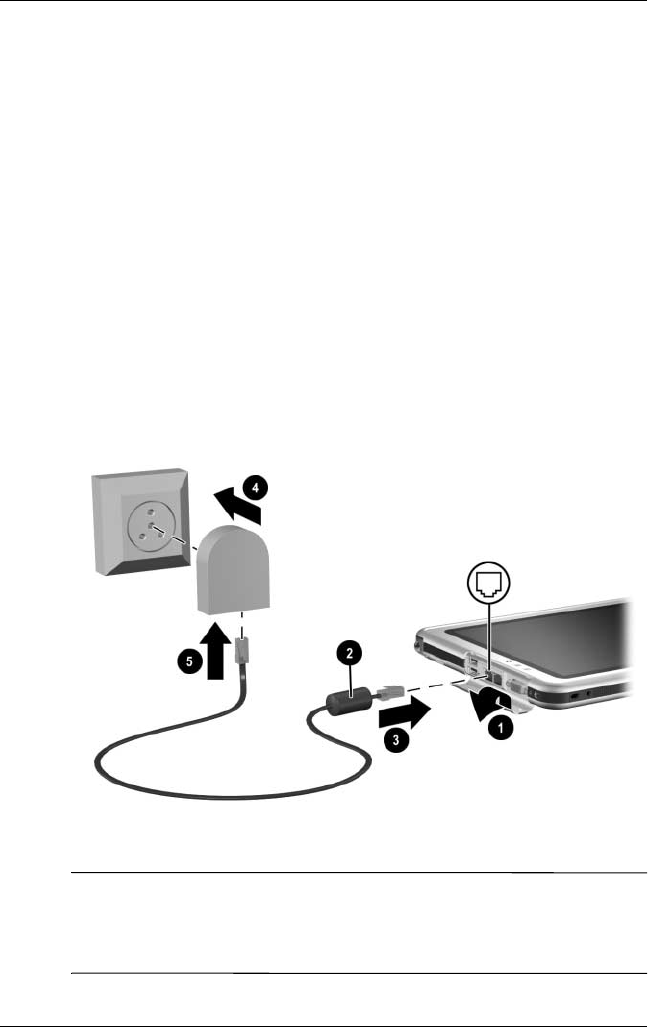
6–4 Hardware Guide
Internal Modem
Connecting the Modem with an Adapter
To connect the modem to an analog telephone line that does not
have an RJ-11 telephone jack:
1. To access the RJ-11 jack 1, open the upper panel of the
tablet PC.
2. If the modem cable has noise suppression circuitry 2, which
prevents interference with TV and radio reception, orient the
circuitry end of the cable toward the tablet PC.
3. Plug the modem cable into the RJ-11 telephone jack 3 (not
the RJ-45 network jack) on the tablet PC.
4. Plug the modem cable 4 into the country-specific modem
adapter.
5. Plug the country-specific modem adapter 5 into the
telephone jack.
Connecting the modem with a modem adapter
(Telephone wall jacks vary in appearance by region.)
ÅWARNING: To reduce the risk of electric shock, disconnect the modem
from the telephone network before accessing an internal compartment
of the tablet PC. Internal compartments include the memory and
Mini PCI compartment and the hard drive bay.
331734-001.book Page 4 Monday, July 14, 2003 3:47 PM

Internal Modem
Hardware Guide 6–5
Setting Country Preferences
The internal modem is configured to function in and meet the
operating standards of the country in which you purchased
the tablet PC. To use the internal modem in other countries, you
must add country-specific modem configurations.
Displaying the Current Country
Configuration
To display the current country configuration, select Start >
Control Panel > Date, Time, Language, and Regional Options
category > Regional and Language Options icon > Regional
Options tab. The current country configuration of the modem is
displayed in the Location panel.
Adding a Country Configuration
ÄCAUTION: To prevent loss of your current country configuration, do not
delete or replace your current country configuration. Additional country
configurations can be added without deleting the current configuration.
ÄCAUTION: To prevent modem malfunction and violation of
telecommunications regulations and laws, use the modem only with the
country configuration for the country in which you are using the modem.
To add a country configuration:
1. Select Start > Control Panel > Network and Internet
Connections category.
2. From the See Also menu in the left column of the window,
select Phone and Modem Options > Dialing Rules tab.
✎If you do not see the Dialing Rules tab when you select Phone
and Modem Options, complete the fields in the Location
Information wizard. After you save the settings on the
Location Information wizard, the Dialing Rules tab is displayed.
331734-001.book Page 5 Monday, July 14, 2003 3:47 PM

6–6 Hardware Guide
Internal Modem
3. Select the New button, then type a name for the new location
in the Location Name field.
4. Select a country or region for the new location from the
Country/Region list.
If you select a country or region that is not supported by the
modem, the country configuration defaults to USA or UK.
5. Select the OK button > OK button.
Solving Travel Connection Problems
If you experience connection problems while using the modem
outside the country in which you purchased the tablet PC, the
following suggestions may be helpful.
Before changing any settings, you may want to write down your
current settings so you can quickly replace those settings when
you return home.
Check the Line
The modem requires an analog, not a digital, telephone line.
A line described as a PBX line is usually a digital line. A
telephone line described as a data line, fax machine line, modem
line, or standard telephone line is probably an analog line.
Check the Dialing Mode
Dial a few digits on the telephone, then listen for clicks or tones.
Clicks indicate that the telephone line supports pulse dialing;
tones indicate that the telephone line supports tone dialing. To set
the internal modem to support either pulse or tone dialing:
1. Select Start > Control Panel > Network and Internet
Connections category.
2. From the See Also menu in the left column of the window,
select Phone and Modem Options > Dialing Rules tab.
331734-001.book Page 6 Monday, July 14, 2003 3:47 PM

Internal Modem
Hardware Guide 6–7
3. Select your location, then select the Edit button.
4. Select the Tone or Pulse radio button.
5. Select the OK button > OK button.
Check the Telephone Number
Dial the telephone number on the telephone, verify that the
remote modem is answering, then hang up.
Check the Dial Tone
If the modem receives a dial tone it does not recognize, it will not
dial and will display a No Dial Tone error message.
■To set the modem to ignore all dial tones before dialing:
1. Select Start > Control Panel > Network and Internet
Connections category.
2. From the See Also menu in the left column of the
window, select Phone and Modem Options >
Modems tab.
3. Select your modem > Properties button > Modem tab.
4. Clear the Wait For Dial Tone Before Dialing check box.
5. Select the OK button > OK button.
■If you continue to receive the No Dial Tone error message
after clearing the check box:
1. Select Start > Control Panel > Network and Internet
Connections category.
2. From the See Also menu in the left column of the
Network and Internet Connections window, select Phone
and Modem Options > Dialing Rules tab.
3. Select your location, then select the Edit button.
4. Select your location from the Country/Region list.
✎If you select a country or region that is not supported by the
modem, the country configuration defaults to USA or UK.
5. Select the OK button.
331734-001.book Page 7 Monday, July 14, 2003 3:47 PM

6–8 Hardware Guide
Internal Modem
6. In the Phone and Modem Options window, select the
Modems tab.
7. Select your modem > Properties button > Modem tab.
8. Clear the Wait For Dial Tone Before Dialing check box.
9. Select the OK button > OK button.
Accessing Communication Software
To access preinstalled modem software, including software
for terminal emulation and data transfer, select Start > All
Programs > Accessories > Communications, then select an
application, wizard, or utility.
Finding AT Command Information
It is not necessary to use AT commands with most modem
software. If you prefer to use AT commands, refer on this CD to:
■Modem Command Guidelines for information about
accessing Hyperterminal, identifying the modem in your
tablet PC, and using AT commands.
■The Soft Modem AT Command Reference Manual for the
AT commands supported by your modem. This guide is
provided in English only.
331734-001.book Page 8 Monday, July 14, 2003 3:47 PM